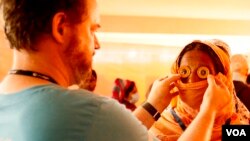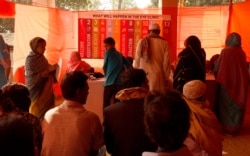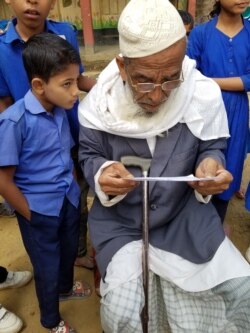The line formed early in the morning, dozens deep, with adults clutching pieces of paper they hoped would be their tickets to an improved outlook.
Each paper authorized admission to a free, pop-up vision clinic, organized at the Kutupalong Government Primary School in Bangladesh for a couple of days in mid-February. Teachers, youngsters in blue uniforms and a traffic crossing guard in blaze-orange vest joined mothers and children, merchants, elders and others in the queue.
“We’ll see about 500 people today,” including almost everyone in the school community, said Maud Zeller-Tillai, a regional manager with OneSight. The U.S.-based vision charity partnered with other aid groups, including the Bangladesh Rural Advancement Committee (BRAC), on the weeklong clinic wrapping up that day.
One of the first to be screened was 9-year-old Riduwan. Wei Lin, an optometrist from Australia, examined the boy and learned that his vision was blurry beyond an arm’s length. Within half an hour, he was fitted with corrective lenses popped into flexible red frames.
“After they’ve given me glasses, it’s clear everywhere,” said Riduwan, whose mother had brought him from the nearby town of Ukhiya.
By day’s end, roughly nine out of 10 patients would be outfitted with glasses or referred for more advanced treatment for conditions such as cataracts and glaucoma, Zeller-Tillai said.
The vision-testing team – which included 11 optometrists and a support staff of nine – had found consistently high levels of need while examining ethnic Rohingyas living in nearby refugee camps earlier in the week before shifting to this town to treat local Bangladeshis.
All told, they examined some 1,700 patients in southeastern Bangladesh’s Cox’s Bazar district. It’s one of the country’s poorest regions, with residents struggling even before more than 700,000 desperate Rohinyas surged across the border from neighboring Myanmar to escape military-led violence that escalated in August 2017.
Now, roughly 855,000 Rohingyas live among 34 crowded camps, with 440,000 people living in the host communities nearby. Governments and aid groups are trying to give more support to those communities to build social cohesion and offset any resentment among locals, who have reported falling wages and rising prices since the massive refugee influx.
“We were expecting a huge need for eye care, as there are no major service providers nearby and also it [is] a vulnerable community,” optometrist Srinivas Marmamula, the team’s medical co-leader, wrote in a follow-up email. He’s a public health officer at the LV Prasad Eye Institute in Hyderabad, India.
“It was heartening to see them smile when they received spectacles and were able to see clearly for the first time,” Marmamula said of the patients.
Among them was Abdul Hakim, a slight man of 75. After his appointment, he sat in the school courtyard, surrounded by youngsters. Worsening vision had constrained his daily activities, including his ability to read the Quran. He put on his new glasses, studied a piece of paper and read a few sentences aloud.
“With these glasses,” he said, “maybe I’ll be able to read for a long time.”
The week’s clinics were the first in Bangladesh for OneSight, which calls its volunteers and allies “visionaries.” The independent nonprofit provides care in at least 49 countries, including the United States.








